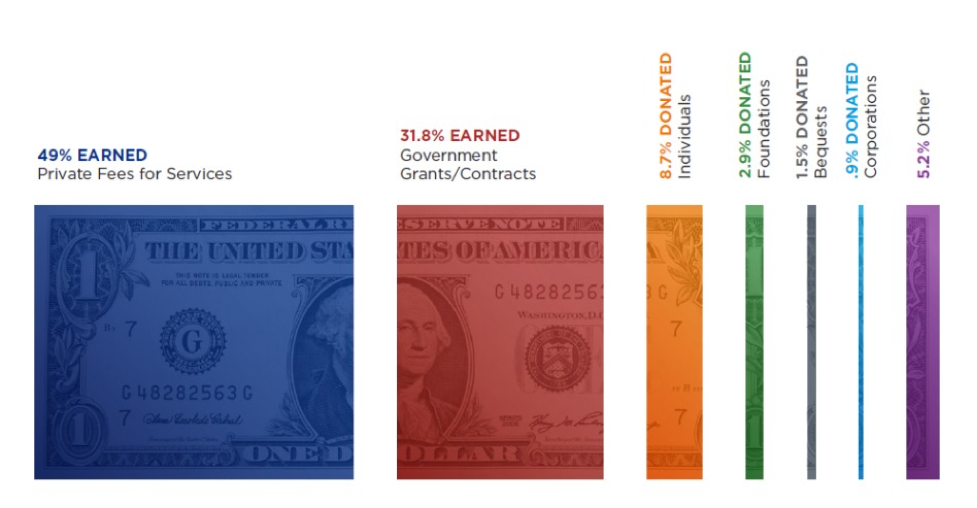6 Philanthropy and Charitable Giving
Learning Objectives
After reading this chapter, you should be able to:
- Understand why people give to nonprofit organizations.
- List the ways nonprofits access financial resources.
- Consider contemporary critiques of philanthropy.

6.1 Chapter introduction
Despite the Covid-19 pandemic, or perhaps because of it, charitable giving in the United States reached an all-time high in 2020: $471 billion, a 15% increase over the previous year.[1]
Perhaps this shouldn’t be a surprise, but nonprofit organizations usually need financial resources in order to meet their mission as organizations. Larger organizations need to pay staff salaries, pay to implement their programs and pay rent and utilities. Even small, community-based organizations without staff often require a modest budget to be able to implement their plans – from purchasing necessary supplies and equipment, to marketing their work (printing flyers and brochures, media campaigns), to reimbursing volunteers for travel expenses. It seems sometimes that nonprofit organizations are always on the hunt for more resources to support their work.
In this chapter, we will discuss the various revenue streams that organizations use to raise the funds they need. We will also cover some of the leading theories that explain why people give money to nonprofit organizations. We will finish with a short discussion of some of the critiques of philanthropy in the United States and around the world.
6.2 Defining philanthropy and charitable giving
Although I think we all know what philanthropy means, there is quite a bit of diversity for the terms used by scholars and practitioners. Merriam-Webster defines philanthropy as “goodwill to fellow members of the human race.” While it usually relates to financial donations, sometimes “gifts” of time (volunteering) is also included (see Chapter 5 for more on volunteering).[2] It is often perceived as altruistic, benefitting others.
When people think of philanthropy, they often first think of wealthy individuals who give a significant amount of their wealth away through one form or another – from a single gift to a favorite organization to setting up a family foundation in their name. Those foundations then make their own grants to organizations, sometimes for decades or longer. Take a look at MacKenzie Scott as she seeks to give away a significant proportion of her wealth.

Foundations
Foundations are a specific type of nonprofit organization, often with a primary goal to help collect and distribute money to other nonprofit organizations. The Council of Foundations defines a foundation as “an entity that supports charitable activities by making grants to unrelated organizations or institutions or to individuals for scientific, educational, cultural, religious, or other charitable purposes.” These organizations must pay out at least 5% of their assets each year in grants.
Private foundations are founded by an individual, family or corporation.
Public Charities may also provide grants to other individuals and organizations, but they are generally supported by the public at large, rather than a single person or business. Community foundations are included in this category, as they raise their money and often distribute those funds in specific communities.
Explore more about foundations at the Council on Foundations.
Image: “Sidewalk Stencil: Your existence gives me hope” by Franco Folini is licensed under CC BY-SA 2.0
Charitable giving, on the other hand, often means any gift of money, time, goods or services to those in need. It also usually refers to individual gifts, rather than institutional gifts from foundations or corporations.
Both scholars and practitioners often use these two terms – philanthropy and charitable giving – interchangeably.
Charitable giving across cultures and faiths
Like volunteering, different groups of people tend to give money away to charity differently. Different parts of the country tend to give at different rates, and “blue states” tend to give less than “red states.” The main driver for this seems to be religious practice. Those who attend religious services more frequently tend to give more often – and even give more – than those who don’t.
Among different racial and ethnic group, Black donors tend to donate a higher proportion of their wealth than white donors. This trend also holds for the Latino/a/x and Asian communities.
6.3 Why people give
One of the big challenges facing scholars who study charitable giving and philanthropy is understanding why people donate money to causes and organizations that they do not directly benefit from. Classical economics would argue that charitable giving is irrational. That is, in an effort to maximize their own best interest, or maximizing their utility, individuals shouldn’t be expected to give away their wealth with no expectation of any benefit in return. There are several different theories to explain why otherwise self-interested individuals will give money away.
Public goods provision. Economists argue that individuals desire a certain level of public goods in their communities (such as education, the arts, human services), and they will contribute their own money to support the provision of these services up to the point where government steps in to support the provision of the good. In this way, government provision could be seen as crowding-out private philanthropy.[3] In other words, every dollar of government provision for a public good will lead to donors giving one dollar less in charitable giving. Yet, research has found that people do tend to contribute past the point of government funding, leading to only a partial crowding-out.[4]
Impure Altruism and Warm-glow. Economist James Andreoni argued that individuals are rarely purely altruistic.[5] That is, they don’t engage in charitable giving with no real expectation of a benefit. Rather, people are engaged in what he calls impure altruism. He suggests that individuals often give to charity because doing so makes them feel good – what he calls a warm glow. This outcome is a powerful benefit received by the donor that can incentivize them to give away a part of their wealth.
Reputational Concerns. Outside of making a donor feel good, charitable giving can also improve one’s reputation in the community. Since people want to be seen as “good,” charitable giving is one way someone can demonstrate that they are a good person that can be respected.[6]
Signaling. Related to reputational benefits, wealthy people might give financial gifts to organizations in order to signal, or demonstrate, their wealth to their communities.[7]
Peer Pressure. Individuals are influenced by peer pressure; they want to behave in similar ways to others. One tool that has been shown to influence charitable giving is called social information – when giving behavior of others is shown to potential donors, they tend to give in similar ways.[8]

Discussion: Theories of Charitable Giving
In 2013, Jen Shang and Rachel Croson published the results from an experiment with a public radio station conducting a fundraising drive. During these drives, on-air personalities encourage listeners to call-in and make a financial contribution to support the station and the programming they enjoy.
As part of the experiment, potential donors who called in were randomly assigned to different treatment groups. Some donors were informed that a “previous donor” had contributed $75 (or $180 or $300), then asked “How much would you like to pledge today?” The control group in the experiment was not given any information about a previous donor’s gift.
Not surprisingly, donors who received information about previous donors often gave more than those donors who did not receive this information.
Discussion questions:
- For donors who are calling in to the station, what might be one motivation for giving? Which theory or theories might explain why people give to support public radio?
- Which theories were Shang and Croson using in their experiment with the potential donors to potentially increase their gift?
- If you were a fundraising manager, what messages might work best if you think people are motivated by the different theories?
Image: “Mel Aguilar at Indiana Public Radio” by susi.bsu is licensed under CC BY 2.0
6.4 How else do organizations raise money?
Believe it or not, individual, foundation and corporate donors give less than 20% of the money that flows into the nonprofit sector every year. Donations from individuals only account for 9% of the nonprofit sector’s revenue.

Image: Nonprofit Impact Matters [pdf] (2019) by the National Council of Nonprofits
What surprises you about the image above? To me, the fact that private foundations only account for 2.9% of the revenue of the nonprofit sector is surprising. Corporate donations, too, account for less than one percent!
Instead, the vast majority of the money that nonprofit organizations receive every year – upwards of 80% of it – comes from either government contracts/grants or fees for service.[9] Government contracts and fees for service are often called earned income, where there is a payment of some sort in exchange for a service provided by the organization. Under the fees for service category above, the largest proportion are the fees private insurance pays for medical care and tuition for nonprofit colleges and universities. However, it can also include tickets to a musical concert, or a museum, or the sales at thrift stores run by nonprofit organizations.
One form of earned income, and one that is growing, is social enterprises. We will discuss social enterprises in much more detail in Chapter 8, but for the purpose of fundraising, a social enterprise can be any organization that uses the market to create social value. In this case, any nonprofit that seeks to generate additional money through sales of a good or service could be included in our definition of social enterprises.

Can Philanthropy Solve Social Problems?
As we have seen above, donations from individuals are only 9% of the revenue that flows into the nonprofit sector. Many scholars and nonprofit leaders have pointed out that even a significant amount of philanthropy is often not adequate to solve the problems communities face – we discussed this in Chapter 2 when we talked about voluntary failure.
Taking things a step farther, some scholars and community leaders challenge the notion that philanthropy is always a force for good and have become critical of the role of philanthropy in our society. Consider these facts:
- Most charitable giving does not go to organizations that serve the poor or most needy.
- Large-donor philanthropy from individuals or private foundations rarely fund advocacy efforts to push for significant social or policy change and dismantle systems of oppression like racism.
- Wealthy individuals give a smaller proportion of their income to charity than middle-class and working-class households.
- Our tax laws regarding charity benefit the wealthy more than middle-class and working-class families. Only the most wealthy are able to receive the tax deduction promised by many charitable organizations for their gifts. Individuals that do not itemize their expenses on their annual tax returns – which are the majority of those in the United States – receive no benefit from their charitable gifts.
Discussion Questions:
- Should we just give up on philanthropy as a way to address social problems?
- With so much attention to the social issues many communities continue to face, why have these inequities in charitable giving and beneficiaries been allowed to persist?
- What might be some policy changes to encourage more charitable giving to those most in need?
- What are other options to ensure that those most in need are able to get the services they would benefit from?
- Haleluya Hadero, “Charitable Giving in the U.S. Reaches All-Time High in 2020,” AP NEWS, June 15, 2021, https://apnews.com/article/philanthropy-health-coronavirus-pandemic-business-94cac51d5caf18f48a7827de04e017c0. ↵
- Robert L. Payton and Michael P. Moody, Understanding Philanthropy: Its Meaning and Mission (Indiana University Press, 2008). ↵
- Burton A. Weisbord, “Private Goods, Collective Goods: The Role of the Nonprofit Sector Charitable Organizations,” Research in Law and Economics Supplement 1 (1980): 139–70. ↵
- James Andreoni, “An Experimental Test of the Public-Goods Crowding-Out Hypothesis,” The American Economic Review 83, no. 5 (1993): 1317–27. ↵
- J. Andreoni, “Impure Altruism and Donations to Public Goods: A Theory of Warm-Glow Giving,” The Economic Journal 100, no. 401 (1990): 464–77. ↵
- David Reinstein and Gerhard Riener, “Reputation and Influence in Charitable Giving: An Experiment,” Theory and Decision 72, no. 2 (February 1, 2012): 221–43, https://doi.org/10.1007/s11238-011-9245-8. ↵
- A. Glazer and K. A Konrad, “A Signaling Explanation for Charity,” The American Economic Review 86, no. 4 (1996): 1019–28. ↵
- J. Shang and R. Croson, “A Field Experiment in Charitable Contribution: The Impact of Social Information on the Voluntary Provision of Public Goods,” The Economic Journal 119, no. 540 (2009): 1422–39. ↵
- Mark Hrywna, “80% Of Nonprofits’ Revenue Is From Government, Fee For Service,” The NonProfit Times, September 19, 2019, https://www.thenonprofittimes.com/news/80-of-nonprofits-revenue-is-from-government-fee-for-service/. ↵

